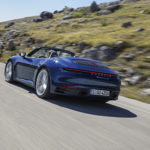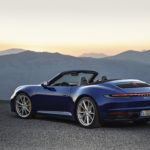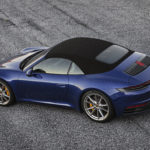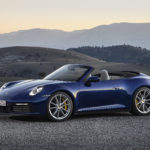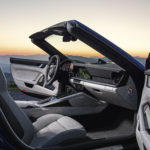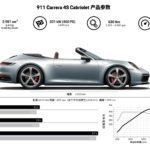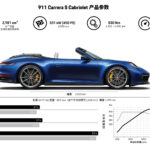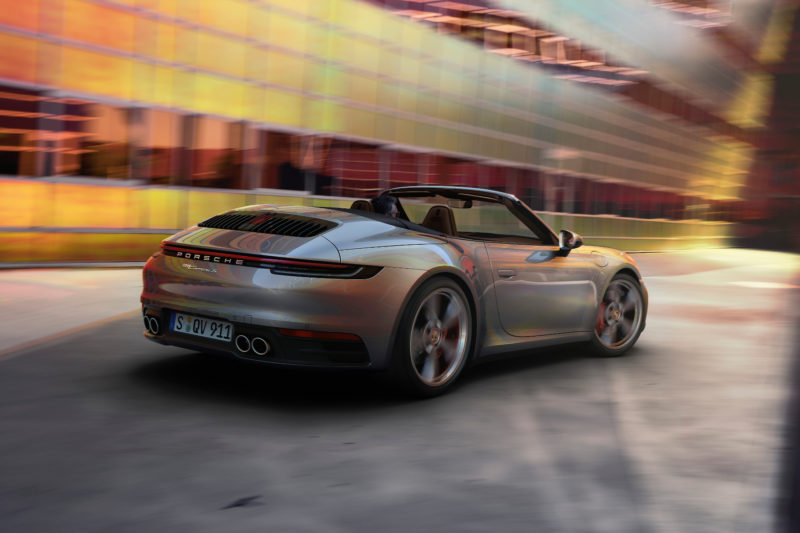
The first open-top 911 was constructed in 1964. Though not a true Cabriolet, this open air 911 actually laid the groundwork for the 911 Targa of 1967. This diversion in to soft windows, removable roof panels, and rollover hoops did not deter Porsche. In September, 1981 a prototype 911 Cabriolet debuted at the Frankfurt Motor Show, with the consumer cars entering production about a year later. For more than 35 years, the Cabriolet has been a fixture in the 911 lineup.
Following the introduction of the new 992-generation 911 coupe a few months ago, the arrival of a Cabriolet was only a matter of time. The new Cabriolet shares the Coupe’s technological advances, as well as revised front-end styling which draws the 992 closer to the Panamera.
Updated Exterior Design
The 992 Cabriolet carries over the Coupe’s updates to classic 911 themes, including more muscular design language with wider haunches. The standard wheels now measure 20″ in diameter at the front and 21″ at the rear, and the front and rear tracks have been widened 45 and 44mm respectively. The car retains a traditional low bonnet between raised fenders.
The rear incorporates a wider variable-position spoiler above a full-width rear light bar; the latter recalling 911 taillights from more than 20 years of air-cooled 911 production. With the exception of the composite bumpers, the entire skin is aluminum.
The convertible top apparatus has been revised with a new hydraulic system. The top can now be operated at speeds of up to 50 km/h (31 mph), and can open or close in about 12 seconds. Bows are constructed from magnesium, and are designed to reduce ballooning of the top material at high speed. An electrically actuated wind deflector is provided for occupants.
Revamped Cabin
The interior design language has been similarly updated, emphasizing clear, straight lines and clear instruments. The new dash layout more clearly evokes the simple, handsome air-cooled cars, and extends the full width between the door posts on a single plane. The centrally-located tachometer is flanked by a pair of frameless freeform displays, and the center display has grown to 10.9″. Ergonomics have been empahasized, allowing operation of Porsche Communication Management functions quickly and without distraction.
More Potent Powertrains
The Cabriolet will initially be offered only in Carrera S and Carrera 4S configurations. Both rely on the same turbocharged 2,981cc flat-six engines as their Coupe counterparts, and are rated at 450PS at 6,500 rpm and 530 Nm of torque from 2,300 through 5,000 rpm. This powerplant offers not only improved power, but greater efficiency and reduced emissions compared to the outgoing unit. Power is transmitted via a new eight-speed dual clutch transmission.
Porsche quotes 0-60 sprints of 3.9 seconds for the standard Carrera S, and 3.7 seconds for the Carrera S with Sport Chrono package. Both of these figures are improved by one tenth of a second for the all-wheel drive Carrera 4S.
Due to a revised engine mounting position, the 992 Cabriolet has also been made more rigid than the outgoing car. As a result Porsche Active Suspension Management (PASM) has been made available for the first time on a 911 Cabriolet. Springs and anti-roll bars are now more rigid, and the chassis sits 10mm lower.
Pricing
The 911 Carrera S Cabriolet starts from 134,405 euros in Germany and the 911 Carrera 4S Cabriolet from 142,259 euros, with US market pricing not yet available.

